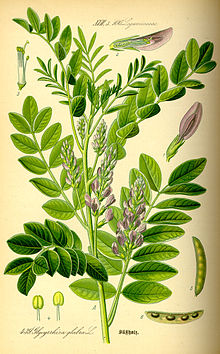Liquorice
| Liquorice | |
|---|---|

| |
| Scientific classification | |
| Kingdom: | Plantae |
| Clade: | Tracheophytes |
| Clade: | Angiosperms |
| Clade: | Eudicots |
| Clade: | Rosids |
| Order: | Fabales |
| Family: | Fabaceae |
| Subfamily: | Faboideae |
| Clade: | Inverted repeat-lacking clade |
| Genus: | Glycyrrhiza |
| Species: | G. glabra
|
| Binomial name | |
| Glycyrrhiza glabra | |
| Synonyms[2][3][4] | |
| |
Liquorice(British English) orlicorice(American English;IPA:/ˈlɪkərɪʃ,-ɪs/LIK-ər-ish, -iss)[5][6]is thecommon nameofGlycyrrhiza glabra,aflowering plantof the bean familyFabaceae,from the root of which a sweet, aromatic flavouring isextracted.[7]
The liquorice plant is anherbaceousperenniallegumenative toWestern Asia,North Africa,andSouthern Europe.[1]Liquorice is used as a flavouring in confectionery,tobacco,beverages, andpharmaceuticals,and is marketed as adietary supplement.[7][8]
Liquorice extracts have been used inherbalismandtraditional medicine.[7]Excessive consumption of liquorice (more than 2 mg/kg [3.2×10−5oz/lb] per day of pureglycyrrhizinic acid,a key component of liquorice) can lead to undesirable consequences. Clinically, it is suspected that overindulgence in liquorice may manifest as unexplainedhypertension,low blood potassium levels (hypokalemia), and muscle weakness in individuals.[7][8][9]Consuming liquorice should be avoided during pregnancy.[8]
Etymology[edit]
The wordliquorice,orlicorice,is derived via theAnglo-Frenchlycorys,fromLate Latinliquiritia,[10]itself ultimately derived from Greekγλυκύρριζα,glykyrrhiza(theModern Greekspelling of the genus isγλυκόριζα,glykoriza)[11]literally meaning 'sweet root' and referring toGlycyrrhiza glabra.[12]
The latter gives the plantbinomial namewithglabrameaningsmooth[13]and referring to the plant's smooth husks; the former came to being via the influence ofliquere,'to become fluid', reflecting the method of extracting the sweet component from the roots.[14]
As of 2021[update],its English common name is spelled 'liquorice' in most of theCommonwealth,but 'licorice' is also used in some countries.[7][15][16]
Description[edit]
Liquorice is aherbaceousperennial,growing to 1 metre (40 in) in height, withpinnateleavesabout 7–15 cm (3–6 in) long, with 9–17 leaflets. Theflowersare8–12 mm (5⁄16–1⁄2in) long, purple to pale whitish blue, produced in a looseinflorescence.Thefruitis an oblongpod,20–30 mm (3⁄4–1+1⁄8in) long, containing severalseeds.[17]The roots arestoloniferous.[18]
Chemistry[edit]


Liquorice root containstriterpenoids,polyphenols,andpolysaccharides.[8]Flavonoidsaccount for the yellow root color.[8]The principalglycoside,glycyrrhizin, exists in content of 7% to 10%, depending on cultivation practices.[8]Theisoflaveneglabreneand the isoflavaneglabridin,found in the roots of liquorice, arephytoestrogens.[19][20]
The scent of liquorice root comes from a complex and variable combination of compounds, of whichanetholeis some 3% of total volatiles.[citation needed]Much of thesweetnessin liquorice comes from glycyrrhizin, which has 30–50 times the sweetness ofsugar.[citation needed]The sweetness is different from sugar, being less instant, tart, and lasting longer.
Cultivation and uses[edit]
Liquorice grows best in well-drained soils in deep valleys with full sun. It is harvested in the autumn two to three years after planting.[17]Countries producing liquorice include Turkey, Greece, Iran, and Iraq.[8]
Tobacco[edit]
Liquorice is used as a flavouring agent fortobacco,for flavour-enhancing and moistening agents in the manufacture of American blendcigarettes,moistsnuff,chewing tobacco,andpipe tobacco.[7][8][21]Liquorice provides tobacco products with a natural sweetness and a distinctive flavour that blends readily with the natural and imitation flavouring components employed in the tobacco industry.[8]Liquorice can also be added to cigaretterolling papers.As of 2009[update],the USFood and Drug Administrationbanned the use of any "characterizing flavors" other than menthol from cigarettes, but not other manufactured tobacco products.[22]
Food and confectionery[edit]
This sectionneeds additional citations forverification.(June 2024) |

Liquorice flavour is found in a wide variety ofcandies or sweets.In most of these candies, the taste is reinforced byaniseedoil so the actual content of liquorice is low.
In the Netherlands, liquorice confectionery (drop) is a common sweet sold in many forms. Mixing it withmint,menthol,aniseed,orlaurelis common. It is also mixed withammonium chloride(salmiak); salmiak liquorice in the Netherlands is known aszoute drop('salty liquorice'). Strong,saltysweets are also consumed inNordic countrieswhere liquorice flavoured alcohols are sold, particularly in Denmark and Finland.[citation needed]
Dried sticks of the liquorice root are a traditional confectionery in the Netherlands as were they once in Britain. They were sold simply as sticks ofzoethout('sweet wood') to chew on as a candy.

PontefractinYorkshire,England, is where liquorice mixed with sugar began to be used as a sweet in the contemporary way.[23]Pontefract cakeswere originally made there.[24]In Cumbria, County Durham, Yorkshire and Lancashire, it is colloquially known as 'Spanish', supposedly because Spanish monks grew liquorice root atRievaulx AbbeynearThirsk.[25]
In Italy, Spain and France, liquorice is used in its natural form. The root of the plant is simply harvested, washed, dried, and chewed as a mouth freshener. Throughout Italy, unsweetened liquorice is consumed in the form of small black pieces made only from 100% pure liquorice extract. InCalabria,aliqueuris made from pure liquorice extract and inReggio Emiliaasoft drinkcalled acqua d'orcio is made. In some parts of the Arab world, including Syria, Egypt, and Palestine, it is consumed as a cold beverage, especially in Ramadan.[citation needed]
In southeastern Turkey, such as inDiyarbakır,licorice root is traditionally made into a chilled beverage that is most commonly consumed in summer.[26]
Research[edit]
Properties of glycyrrhizin are under preliminary research, such as forhepatitis Cortopicaltreatment ofpsoriasis,but the low quality of studies as of 2017[update]prevents conclusions about efficacy and safety.[7][8][27]
Traditional medicine[edit]
Intraditional Chinese medicine,a related speciesG. uralensis(often translated as "liquorice" ) is known asgancao(Chinese:Cam thảo;lit.'sweet grass'), and is believed to "harmonize" the ingredients in a formula.[28]although there is no high-qualityclinical researchto indicate it is safe or effective for any medicinal purpose. The European Medical Agency added liquorice to their list of herbal medicine.[29]
Fungicide[edit]
Theessential oilsinhibit the growth ofAspergillus flavus.[30]
Adverse effects[edit]
Consumption levels[edit]
The United StatesFood and Drug Administrationregards that foods containing liquorice and its derivatives (including glycyrrhizin) aregenerally recognized as safefor use as afood ingredient,if not consumed excessively.[7][8][9]Other jurisdictions have suggested no more than 100–200 mg (1.5–3.1 grains) of glycyrrhizin per day, the equivalent of about70–150 g (2+1⁄2–5+1⁄4oz) of liquorice confectionery.[9]Although liquorice is considered safe as a food ingredient, glycyrrhizin can cause serious side effects if consumed in large amounts (above 0.2 mg per kg per day).[7][8][9]One estimate is that a normal healthy person can consume 10 mg (0.15 grains) of glycyrrhizic acid per day.[31]
Because the composition of liquorice extracts in various products may exist in a broad range, there is not enough scientific information to determine that a specific level of intake is safe or unsafe.[7][8]
Physiological effects[edit]
The effects of excessive liquorice consumption onlowering potassium levels in the bloodand increasingblood pressureare a particular concern for people with hypertension (high blood pressure) or heart or kidney disease.[7]
Some adverse effects of liquorice consumed in amounts of 50 to 200 g per day over four weeks appear to be caused byglycyrrhizic acid(75 to 540 mg per day glycyrrhetinic acid) causing increases in blood pressure.[8]Consuming large amounts of liquorice during pregnancy has been associated withpremature birthand health problems in the child.[8]
Hyper-mineralocorticosteroidsyndrome can occur when the body retains sodium, and loses potassium, altering biochemical and hormonal regulation.[9]Some of these activities may include raisedaldosteronelevels, decline of therenin-angiotensin systemand increased levels of theatrial natriuretic hormonein order to compensate the variations in homoeostasis.[9][32]
Other adverse effects may includeelectrolyte imbalance,edema,increasedblood pressure,weight gain, heart problems, and weakness. Symptoms depend on the severity of toxicity. Some other complaints include fatigue,shortness of breath,kidney failure,and paralysis.[33][34]
Potential for toxicity[edit]
The major dose-limiting toxicities of liquorice arecorticosteroidin nature, because of the inhibitory effect that its chief active constituents, glycyrrhizin andenoxolone,have oncortisoldegradation, and includeedema,hypokalaemia,weight gain or loss, andhypertension.[8][9][35][36]
Gallery[edit]
-
Liquorice root with bark
-
Inflorescence ofG. glabra
-
Various liquorice products
-
Different flavoured liquorice sticks
-
Foliage
-
G. glabrafrom Koehler'sMedicinal-Plants
References[edit]
- ^ab"Glycyrrhiza glabra".Germplasm Resources Information Network.Agricultural Research Service,United States Department of Agriculture.Retrieved6 March2008.
- ^"The Plant List: A Working List of All Plant Species".Retrieved2017-03-07.
- ^"Glycyrrhiza pallida Boiss., Diagn. Pl. Orient. ser. 2, 2: 22 (1856)".The International Plant Names Index.Retrieved2017-03-07.
- ^"Glycyrrhiza violacea Boiss., Diagn. Pl. Orient. ser. 2, 2: 23 (1856)".The International Plant Names Index.Retrieved2017-03-07.
- ^"Liquorice".Dictionary.com Unabridged(Online). n.d.
- ^"Licorice".Dictionary.com Unabridged(Online). n.d.
- ^abcdefghijk"Licorice root".National Center for Complementary and Integrative Health, US National Institutes of Health. August 2020.Retrieved11 June2023.
- ^abcdefghijklmnop"Licorice".Drugs.com. 31 January 2022.Retrieved11 June2023.
- ^abcdefgOmar HR, Komarova I, El-Ghonemi M, Fathy A, Rashad R, Abdelmalak HD, Yerramadha MR, Ali Y, Helal E, Camporesi EM (August 2012)."Licorice abuse: time to send a warning message".Therapeutic Advances in Endocrinology and Metabolism.3(4): 125–38.doi:10.1177/2042018812454322.PMC3498851.PMID23185686.
- ^Bradley H, ed. (1908)."Liquorice, licorice".ANew English DictionaryOn Historical Principles (NED).Vol. VI. L to N. Oxford, England: Clarendon Press. p. 332.Retrieved2021-04-07.
- ^"γλυκύρριζα".Epitome of the Kriaras Dictionary (online version)(in Greek).Center for the Greek Language.Portal for the greek language.Retrieved2021-04-07.
- ^γλυκύρριζα.Liddell, Henry George;Scott, Robert;A Greek–English Lexiconat thePerseus Project.
- ^glabra.Charlton T. Lewis and Charles Short.A Latin DictionaryonPerseus Project.
- ^Harper D."Licorice".Online Etymology Dictionary.
- ^"Liquorice".Merriam-Webster.com Dictionary.
- ^"Licorice".Merriam-Webster.com Dictionary.
- ^abHuxley, A., ed. (1992).New RHS Dictionary of Gardening.ISBN0-333-47494-5
- ^Brown, D., ed. (1995). "The RHS encyclopedia of herbs and their uses".ISBN1-4053-0059-0
- ^Somjen D, Katzburg S, Vaya J, Kaye AM, Hendel D, Posner GH, Tamir S (2004). "Estrogenic activity of glabridin and glabrene from licorice roots on human osteoblasts and prepubertal rat skeletal tissues".The Journal of Steroid Biochemistry and Molecular Biology.91(4–5): 241–246.doi:10.1016/j.jsbmb.2004.04.008.PMID15336701.S2CID16238533.
- ^Tamir S, Eizenberg M, Somjen D, Izrael S, Vaya J (2001). "Estrogen-like activity of glabrene and other constituents isolated from licorice root".The Journal of Steroid Biochemistry and Molecular Biology.78(3): 291–298.doi:10.1016/S0960-0760(01)00093-0.PMID11595510.S2CID40171833.
- ^Erik Assadourian,Cigarette Production DropsArchived2011-12-09 at theWayback Machine,Vital Signs 2005,at 70.
- ^"Flavored Tobacco".US Food and Drug Administration. 22 September 2009.Retrieved21 December2017.
- ^"Right good food from the Ridings".AboutFood.com. 25 October 2007. Archived fromthe originalon 7 June 2007.
- ^"The strange story of Britain's oldest sweet".BBC Travel. 2019-07-11.
- ^"Where Liquorice Roots Go Deep".Northern Echo. 13 September 2006.Retrieved9 December2008.
- ^"Lemon, Licorice and Sumac Sherbet: Drinks to beat the Summer Heat".Mediterranean Observer. 22 August 2021.Archivedfrom the original on 29 March 2023.
- ^Yu JJ, Zhang CS, Coyle ME, Du Y, Zhang AL, Guo X, Xue CC, Lu C (2017). "Compound glycyrrhizin plus conventional therapy for psoriasis vulgaris: A systematic review and meta-analysis of randomized controlled trials".Current Medical Research and Opinion.33(2): 279–287.doi:10.1080/03007995.2016.1254605.PMID27786567.S2CID4394282.
- ^Bensky D, et al. (2004).Chinese Herbal Medicine: Materia Medica, Third Edition.Eastland Press.ISBN978-0-939616-42-8.
- ^"Liquiritiae radix".European Medicines Agency.Retrieved1 June2021.
- ^Mamedov NA, Egamberdieva D (2019). "Phytochemical Constituents and Pharmacological Effects of Licorice: A Review".Plant and Human Health, Volume 3.Cham:Springer Publishing.pp. 1–21.doi:10.1007/978-3-030-04408-4_1.ISBN978-3-030-04407-7.S2CID104427400.
- ^Størmer F, Reistad R, Alexander J (1993). "Glycyrrhizic acid in liquorice—Evaluation of health hazard".Food and Chemical Toxicology.31(4): 303–312.doi:10.1016/0278-6915(93)90080-I.ISSN0278-6915.PMID8386690.
- ^Mackenzie MA, Hoefnagels WH, Jansen RW, Benraad TJ, Kloppenborg PW (1990)."The Influence of Glycyrrhetinic Acid on Plasma Cortisol and Cortisone in Healthy Young Volunteers".The Journal of Clinical Endocrinology & Metabolism.70(6): 1637–1643.doi:10.1210/jcem-70-6-1637.ISSN0021-972X.PMID2161425.
- ^Blachley JD, Knochel JP (1980). "Tobacco Chewer's Hypokalemia: Licorice Revisited".New England Journal of Medicine.302(14): 784–785.doi:10.1056/NEJM198004033021405.ISSN0028-4793.PMID6986557.
- ^Toner JM, Ramsey LE (1985). "Liquorice can damage your health".Practitioner.229(1408): 858–860.PMID4059165.
- ^Olukoga A, Donaldson D (June 2000). "Liquorice and its health implications".The Journal of the Royal Society for the Promotion of Health.120(2): 83–9.doi:10.1177/146642400012000203.PMID10944880.S2CID39005138.
- ^Armanini D, Fiore C, Mattarello MJ, Bielenberg J, Palermo M (September 2002). "History of the endocrine effects of licorice".Experimental and Clinical Endocrinology & Diabetes.110(6): 257–61.doi:10.1055/s-2002-34587.PMID12373628.
External links[edit]
- .Encyclopædia Britannica.Vol. 16 (11th ed.). 1911.
- Glycyrrhiza glabra(licorice),Kew plant profile
- What's That Stuff?: Licorice,Chemical & Engineering News






